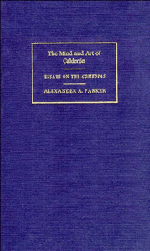Book contents
25 - The destiny of man
Published online by Cambridge University Press: 05 February 2012
Summary
Ángel Valbuena Prat, who emphasised the ‘baroque’ quality of Calderón's art in order to bring him into favour with Spanish readers in the wake of the restoration to favour of baroque poetry in the complex art of Góngora, saw La vida es sueño as a watershed in Calderón's dramatic production. Conflicts and themes of political and social life recognisably ‘real’ had led up to it, but La vida es sueño itself introduced a new type of philosophical and symbolical drama, which was gradually to expand until his death. Valbuena called these ‘las dos maneras’, Calderón's two manners or styles, with no clear-cut chronological division but with a clear progression towards what he defined as baroque, the court plays with their lavish spectacle being the culmination of baroque drama. There is more to this ‘watershed’ metaphor than just the progress towards a more complex type of stage play. What the ‘watershed’ metaphor indicates is a new conception and handling of dramatic plots, initiated in La vida es sueño. Its plot could not be called ‘realistic’, although this never bothered its readers, nor did it need to, because there was a poetic pattern that conveyed a life above and beyond that of contemporary society. The unrealism of its basic plot – the imprisonment of a new-born baby in a tower, who acquires no knowledge of other men or of the world, until he grows to manhood and is released – was explained in chapter 7 as a symbolic mode, meaning more than it said, and the Prison–Tower was there called a Calderonian archetype.
- Type
- Chapter
- Information
- The Mind and Art of CalderónEssays on the Comedias, pp. 348 - 359Publisher: Cambridge University PressPrint publication year: 1989



